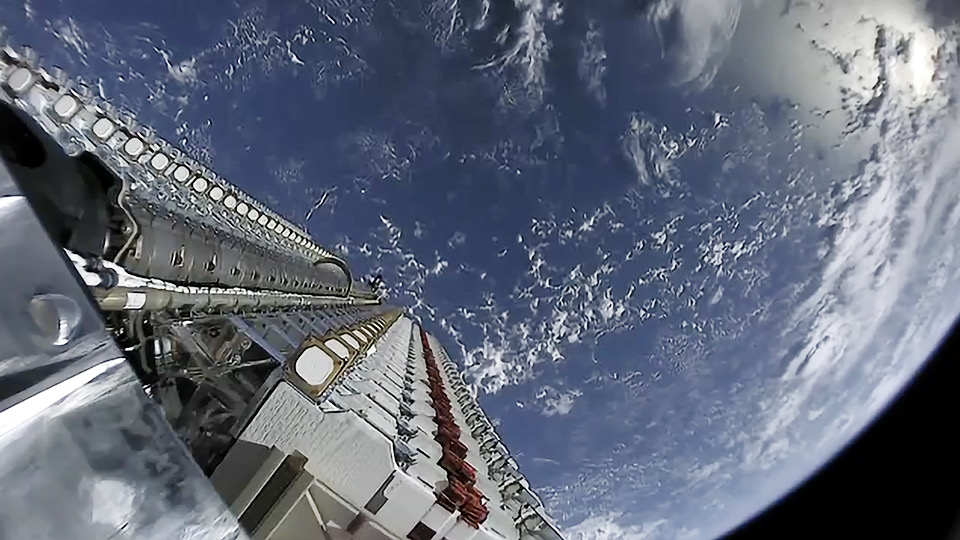
A European Earth-observation satellite performed an evasive maneuver yesterday (Sept. 2) to make sure it didn't collide with one of SpaceX's recently launched internet craft.
The European Space Agency's (ESA) Aeolus satellite fired its thrusters yesterday morning, raising its orbit to pass safely over that of "Starlink 44," one of the first 60 satellites in SpaceX's envisioned internet megaconstellation.
"The manoeuvre took place about 1/2 an orbit before the potential collision. Not long after the collision was expected, #Aeolus called home as usual to send back its science data — proving the manoeuvre was successful and a collision was indeed avoided," ESA officials said via Twitter yesterday.
"It is very rare to perform collision-avoidance manoeuvres with active satellites. The vast majority of ESA avoidance manoeuvres are the result of dead satellites or fragments from previous collisions. #SpaceDebris," they added in another tweet.
Related: SpaceX's 1st Starlink Satellite Megaconstellation Launch in Photos
It is very rare to perform collision avoidance manoeuvres with active satellites. The vast majority of ESA avoidance manoeuvres are the result of dead satellites or fragments from previous collisions#SpaceDebris pic.twitter.com/mjbdoFfCPaSeptember 2, 2019
ESA took action after learning from the U.S. military that the probability of a collision was 1 in 1,000 — 10 times higher than ESA's threshold for conducting a collision-avoidance maneuver — Forbes reported yesterday.
ESA reached out to SpaceX, which apparently also received the same collision alert. But SpaceX declined to move Starlink 44, said Holger Krag, who heads ESA's Space Debris Office.
Get the Space.com Newsletter
Breaking space news, the latest updates on rocket launches, skywatching events and more!
"Based on this, we informed SpaceX, who replied and said that they do not plan to take action," Krag told Forbes. "It was at least clear who had to react."
SpaceX traced the company's inaction to a problem with the Starlink paging system. The Starlink team last exchanged emails with Aeolus' handlers on Aug. 28, when the collision risk was in the 1-in-50,000 range, SpaceX representatives told Space.com.
"At that point, both SpaceX and ESA determined a maneuver was not necessary," a company spokesperson said in an emailed statement. "Then, the U.S. Air Force's updates showed the probability increased to 1.69e-3 (or more than 1 in 10k), but a bug in our on-call paging system prevented the Starlink operator from seeing the follow-on correspondence on this probability increase. SpaceX is still investigating the issue and will implement corrective actions. However, had the Starlink operator seen the correspondence, we would have coordinated with ESA to determine best approach with their continuing with their maneuver or our performing a maneuver."
Aeolus launched in August 2018 to monitor Earth's atmosphere and weather, with a special emphasis on better understanding wind patterns. (Aeolus is the god of winds in Greek mythology.) Starlink 44 launched with 59 of its cousins in May of this year, to help lay the foundation for SpaceX's planned internet-satellite constellation.
SpaceX intends to loft many more Starlink craft — perhaps up to 12,000, if everything works well with the satellite network. And several other companies, including Amazon and OneWeb, are developing internet megaconstellations of their own.
Collision-avoidance maneuvers like the one Aeolus performed yesterday may therefore become much more common in the next few years — so common, in fact, that overseeing such operations manually will likely become impossible, ESA officials said.
"ESA is preparing to automate this process using #AI #ArtificialIntelligence. From the initial assessment of a potential collision to a satellite moving out of the way, automated systems are becoming necessary to protect our space infrastructure. #SpaceSafety #SpaceTraffic," ESA officials tweeted yesterday.
There are other potential issues with such huge satellite networks as well. Shortly after this May's Starlink launch, for example, some astronomers raised concerns that the constellation could significantly degrade their views of the night sky.
- SpaceX's 60-Satellite Launch Is Just the Beginning for Starlink Megaconstellation
- Space Junk: Tracking & Removing Orbital Debris
- Little Legal Recourse for Astronomers Concerned About Starlink
Mike Wall's book about the search for alien life, "Out There" (Grand Central Publishing, 2018; illustrated by Karl Tate), is out now. Follow him on Twitter @michaeldwall. Follow us on Twitter @Spacedotcom or Facebook.
Join our Space Forums to keep talking space on the latest missions, night sky and more! And if you have a news tip, correction or comment, let us know at: community@space.com.

Michael Wall is a Senior Space Writer with Space.com and joined the team in 2010. He primarily covers exoplanets, spaceflight and military space, but has been known to dabble in the space art beat. His book about the search for alien life, "Out There," was published on Nov. 13, 2018. Before becoming a science writer, Michael worked as a herpetologist and wildlife biologist. He has a Ph.D. in evolutionary biology from the University of Sydney, Australia, a bachelor's degree from the University of Arizona, and a graduate certificate in science writing from the University of California, Santa Cruz. To find out what his latest project is, you can follow Michael on Twitter.









